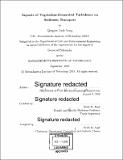| dc.description.abstract | Aquatic vegetated habitats, including wetlands and mangroves, are disappearing at an annual rate of 1 to 7%. These ecosystems provide habitats important to fisheries, enhance water quality by filtering nutrients from run-off, and also protect coastal regions from storm surges and waves. To mitigate the loss of these habitats, restoration projects import sediment to eroded areas. The success of the restoration depends on its ability to retain sediment; therefore restoration design requires a good understanding of sediment transport within vegetated landscapes. However, there is currently no quantitative model for sediment transport in vegetated regions, and many restoration projects have failed due to unanticipated erosion from the restored regions. The goal of this thesis is to develop a predictive model for sediment transport in regions with vegetation. First, the affect of vegetation on the critical condition when sediment start to move was explored. To identify the critical condition, an imaging system was designed to track the trajectories of individual moving grain through running water. The critical flow velocity (U[subscript crit]) above which sediment starts to move was identified from the tracked sediment trajectories for both bare (non-vegetated) and vegetated regions. The experimental results showed that for the same type of sediment, U[subscript crit] decreased with increasing vegetation solid volume fraction. This was attributed to the vegetation-generated turbulence, which induced a local, vertical, adverse pressure, or a lift force on the sediment grain, facilitating sediment transport. In contrast, the turbulent kinetic energy (k[subscript t]) was found to be roughly a constant at the critical condition for different vegetation volume fractions, suggesting that k[subscript t] is a more universal metric than T for predicting the critical condition of the sediment transport. A k[subscript t]-based model was developed to predict U[subscript crit] for channels with different vegetation solid volume fractions. The turbulence-based model successfully predicted U[subscript crit] for both bare and vegetated channels, providing a useful tool for ecologists to predict whether a vegetated landscape will erode or not. Second, the impact of vegetation on the bed load transport rate was explored. A system that allows sediment to be bypassed, a cart to distribute sediment, a method that measures the dry weight of wet sand without drying the sediment, a topography system, and an sediment trajectory imaging system were designed. The bed load transport rate (Q[subscript s],) was measured for both bare channels and channels with different vegetation solid volume fractions ([phi]) under different flow rates. At the same [tau], the measured Q[subscript s], increased with increasing [phi], suggesting that vegetation-generated turbulence, which also increased with increasing ]phi], was augmenting the bed load transport. At the same near-bed turbulent kinetic energy, k[subscript t], the Q[subscript s], measured in both bare and vegetated channels agreed within uncertainty, suggesting that k[subscript t] may be a more universal predictor of Q[subscript s] than [tau]. The Einstein-Brown [tau]-based bed load transport model was reinterpreted as a k[subscript t]-based model. The new kt-based model predicted the Q[subscript s] measurements for both bare and vegetated channels. The dependence of Q[subscript s] on k[subscript t] was explained by the statistics of individual grain motion, which showed that Q[subscript s] was predominantly controlled by the number of grains in motion, which correlated with k[subscript t]. The proposed k[subscript t]-based sediment transport model can be used to simulate large-scale landscape evolution and to help ecologists design better coastal restoration strategies. Third, the impacts of vegetation on bed-form characteristics and migration rate were studied. After the measured bed load transport rate converged to an equilibrium value, the bed topography was scanned by a laser topography system. Bed-forms with height less than 2cm were observed and characterized as ripples. For low vegetation solid volume fraction ([phi] </_ 0.012), the ripple wavelength was constrained by stem spacing and the ripple height increased with increasing [phi]. However, at the highest vegetation solid volume fraction ([phi] = 0.025), the ripple height was comparable to the grain size, indicating that an plane bed had formed. The ripple migration speed and the bed load flux associated with the migrating ripples increased with increasing vegetation solid volume fraction for [phi] </_ 0.012. However, the fraction of the bed load flux carried by migrating ripples decreased with increasing [phi], suggesting that vegetation facilitated the formation of sheet flow. The impacts of vegetation on bed-forms presented here will provide a potential tool for geologists to infer the occurrence of vegetation-related events from geomorphological records. | en_US |
